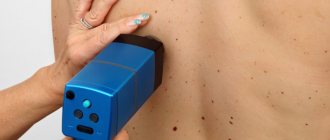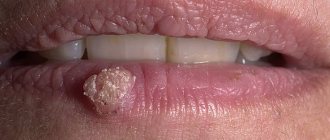Home / Articles / What to do if a red mole bursts?
The color of red moles (angiomas) is due to the large number of blood vessels in this area. Such neoplasms can be congenital or acquired, disappear and appear spontaneously. In most cases they are benign, but the risk of malignancy cannot be excluded. It can be increased by constant trauma to the skin in this area, abuse of sunbathing, bad habits, and hormonal changes. If a red mole bursts, begins to bleed or grows, you should consult a specialist. He will tell you how to care for the wound and develop a diagnostic program that will exclude tissue malignancy.
Where does a mole begin?
Nevus is considered a benign skin neoplasm, characterized by an accumulation of nevocytes, melanin-rich cells.
This is why the mole has a dark color and fairly clear boundaries.
The transformed melanocytes (nevocytes) take up the thyroid hormone thyroxine and transform it into melanin, which colors the skin in a certain area.
Melanin is necessary for the human body.
It is both an antioxidant and a predictor of anti-stress hormones, softening emotional reactions, and a regulator of sleep and wakefulness.
To be or not to be a mole is determined in the embryonic period, even if the pigment formation appeared after birth.
Some features of pregnancy stimulate the process of melanocyte transformation.
The nevocyte does not have processes, therefore, like a stingy knight, it accumulates all the melanin without giving it to other areas of the skin. You can be born with moles or acquire them during periods of hormonal crises: puberty, pregnancy, menopause, unsuccessful selection of contraceptives.
As well as intense tanning, including in solariums, skin infections, allergies.
Nevocytes form a border nevus at the border of the superficial and deep layers of the skin. then grow into the dermis (mixed or intradermal nevus).
A border nevus is a round, dark, smooth spot.
The mixed one protrudes slightly above the skin.
An intradermal nevus looks larger, rising like a dome on a small stalk, sometimes with hairs, that is, it looks like a dark wart.
The main danger of a nevus is that its cells can become malignant and malignant.
Melanoma, a very dangerous malignant skin tumor, can develop from a melanocytic nevus.
80% of deaths from skin cancer occur with melanomas, although almost all patients who receive timely treatment live quietly for 10-15 years before a new relapse.
Risk factors for malignancy are known.
These are heredity (melanoma or other oncology), ultraviolet radiation (permanent or excessive tanning), sunburn, fair skin and red hair.
Gella, the heroine of The Master and Margarita, could have a predisposition to melanomas.
Let's look at some complaints related to moles.
Why is it dangerous?
Moles are benign formations and are not dangerous until they change shape, start to itch, or bleed. Such symptoms indicate the possible degeneration of the nevus into a malignant formation, which requires the intervention of a doctor. If a person has moles on his body that begin to change, it is important to avoid exposing the suspicious formation to sunlight. You should also refuse to visit the solarium until the necessary tests are carried out at a medical institution and the nature of the mole is determined.
“I picked a mole and it started bleeding”
A person gets used to his moles, chooses clothes, adapts and almost does not notice.
But the mole reminds you of itself, sometimes in a dramatic and even bloody way.
What's happening?
The man says this:
- “I scratched my mole until it bled”
- "knocked off with clothes or nails"
- “damaged a mole” and “bleeded”
- “The cat scratched a mole until it bled”
- and even “the mole burst.”
What to do and what are the dangers?
Blood comes from a mole because the nevus is penetrated by capillaries.
There are also vascular nevi or hemangiomas; they are completely filled with blood.
Damage to a mole: causes
- scratching with nails when combing
- chafing and bleeding due to pressure from clothing or shoes
- cutting with a sharp object in everyday life or for the purpose of “removing a mole” at home
To prevent injury to the nevus, non-compressive clothing is selected, and the mole itself is sealed with a bactericidal plaster.
But what if an injury does occur?
Firstly, like any wound, a cut or damaged nevus can become infected.
Microorganisms enter its cavity and penetrate deeper, causing inflammation.
Symptoms of inflammation of a mole
- pain;
- redness, diffuse or with the formation of a dense red cushion;
- local increase in temperature;
- subsequently suppuration is possible.
If the inflammation is not treated, the wound from the mole can heal by secondary intention, that is, with the appearance of an ugly scar.
Inflammation can spread to neighboring areas, and then the most dangerous injury to moles on the face and neck.
In particularly unfavorable conditions, the process generalizes. that is, sepsis develops, a general blood infection.
In place of the injured nevus, new moles and spots appear, which can spoil the appearance.
If the location contributes to the traumatization of moles (on the fingers, on the neck, on the belt), this process can be repeated again.
The most unpleasant consequence of injury is malignancy of the nevus.
Therefore, even if you easily coped with the bleeding, inflammation did not develop, you still need to consult a specialist.
Prevention
Moles rarely transform into melanoma, even when they have been injured more than once. However, if there are additional symptoms, in addition to bleeding, degeneration is possible. To prevent serious consequences, it is important to pay close attention to nevi and try to protect them from subsequent damage. When taking a bath or shower, you need to use the washcloth carefully and do not press it with increased force, so as not to catch the growth. You also need to be careful when removing hair, whether through waxing or razor removal. If the formation is located on the head, then the combing procedure is carried out as carefully as possible, and the comb is changed to a softer one.
You will also need to avoid aggressive exposure to sunlight. They have a particularly adverse effect on moles that are injured and bleeding. Doctors recommend that such patients not sunbathe without using special sunscreens. In addition, if the nevus is located on the face, it would be useful to use cosmetics with an SPF filter. They are recommended to be used not only on the beach or when going to the solarium, but also in everyday life. This is due to the fact that ultraviolet radiation reaches people in the city, even in cloudy and rainy weather.
What other possible signs of malignancy can be seen with the naked eye?
- the nevus grows rapidly;
- the mole hurts, itches, goes numb;
- the mole changes shape: the borders blur, change outline, the surface becomes lumpy;
- many new moles appear;
- the mole darkens, turns blue or red;
- hair on the nevus is actively growing;
- the nevus gets wet;
- the mole is bleeding.
If you notice one or more changes, especially bleeding, you should contact your oncologist as soon as possible.
Melanoma is treatable in the early stages.
Blood from a mole: what to do?
There are a variety of reasons why a mole may bleed, but regardless of the reason, you should take the same steps.
- If the mole is not completely torn off, it is forbidden to cut it off or separate it manually.
- Wash your hands, wipe them with an alcohol wipe, cologne or vodka.
- Treat the surface around the wound with any skin antiseptic. This could be the same alcohol wipe, an alcohol solution of iodine, green brilliantine, fucarcin, or any preparation intended for hand treatment.
- Drop a 3% solution of hydrogen peroxide, chlorhexidine or miramistin (optional) into the wound.
- Cover the wound with a stick-on bandage, an adhesive plaster with a bactericidal “pad”, and fix the part of the mole that has not completely separated in a comfortable position.
Why can't you remove moles?
It is not recommended to comb, cut or rip off nevi, since damage to a benign mole can lead to infection and the development of a tumor. If this does happen, it is necessary to treat the injury site with an antiseptic and stop the bleeding.
The torn mole should be taken to a histology laboratory for examination. If the mole is only partially damaged, you need to pay attention to whether it has changed its color, shape or size after the injury.
Doctors advise removing nevi if, due to their location, they are susceptible to accidental injury and rubbing, as well as in case of suspected degeneration. It is also possible to remove moles for aesthetic reasons.
How to stop bleeding from a mole?
If the blood does not stop on its own during bandaging, it means that the nevus has grown into relatively large vessels and they are injured or you have poor blood clotting.
Bleeding from capillaries is stopped by pressing the vessels.
Place a sterile napkin on the wound, press tightly on top with a piece of cotton wool or a rolled bandage (this is called a “pelote”) and secure the bandage.
Depending on the location of the injury, you may be able to apply a tight bandage or simply apply pressure to the area with a few strips of adhesive tape.
Once you have given yourself first aid, don’t stop there!
Make an appointment with an oncologist or dermatologist.
The nevus must be examined to ensure that there is no gold contamination.
It is advisable to remove the mole.
If the mole “falls off” but there is no blood, perhaps the outer part of the nevus has become dead and separated spontaneously.
In this case, it is advisable not to delay a visit to the dermatologist, since the causes of necrosis are unclear.
Place the separated part in saline or boiled water and save for histological examination.
Factors influencing the rate of wound healing
Healing depends on many factors. The main ones are:
- Blood supply. The tissues must be sufficiently supplied with oxygen, which is delivered by blood. The higher the oxygen concentration in the tissues, the more active the immune system is, the faster the blood vessels and skin are restored, and the production of collagen, one of the most important proteins that plays a key role in the process of tissue regeneration in the human body, accelerates.
- Patient's diet. To produce collagen fibers, you need proteins, minerals, vitamins, and carbohydrates. A large number of these components contain meat, dairy products, and nuts.
- High-quality isolation of the wound from the external environment. Microorganisms that get into the wound not only cause purulent inflammation. They also absorb oxygen, which is so necessary for immune processes.
Diagnosis of a mole (nevus)
A dermatologist performs an external examination of the wound, first without equipment, and then using epiluminescence dermatoscopy.
A biopsy (removal of part of a mole for examination) is not performed, since repeated injury to the nevus is unsafe.
After consulting an oncologist, they decide where exactly the mole will be removed.
The ideal specialist in this case is an oncodermatologist.
But if there is none, you can sequentially visit two medical organizations: dermatovenereal and oncology dispensaries.
After the operation, the material is necessarily sent for histological examination.
It is this that gives the answer to the main question: has a “peaceful” mole become malignant?











